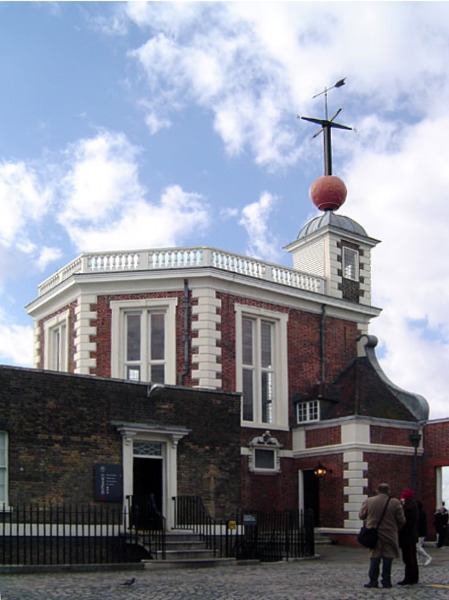Facts for Kids
The Royal Observatory, Greenwich is an observatory located in Greenwich Park, southeast London, with a remarkable view of the River Thames, dedicated to studying astronomy and the history of timekeeping.
Overview
The Prime Meridian
Timekeeping Innovations
Key Contributions To Astronomy
Visiting The Royal Observatory
History Of The Royal Observatory
Architectural Design And Features
Exhibitions And Public Engagement
Notable Astronomers And Scientists
Related Observatories And Institutions

Inside this Article
Caroline Herschel
Space Exploration
John Flamsteed
Los Angeles
Navigators
Astronomy
Standard
Meridian
Universe
Gardens
Did you know?
🌟 The Royal Observatory is a great place to learn about stars and planets!
🏰 It was opened on March 10, 1675, by King Charles II of England.
🌍 The observatory is the starting point for time zones around the world.
⚓ The first Astronomer Royal, John Flamsteed, helped sailors with star charts.
🔭 Inside, you'll find amazing telescopes, including the Great Equatorial Telescope.
🌌 The observatory helped create accurate star maps for navigators.
⏳ The first marine chronometer was invented here in 1762 to help sailors tell time.
🗺️ You can stand on the Prime Meridian at the Royal Observatory!
🌌 Sir William Herschel discovered the planet Uranus in 1781 at the observatory.
🎨 The observatory has fun exhibitions and activities for kids and families.
Introduction
Located in Greenwich Park, southeast London, it has a spectacular view of the River Thames. The observatory was opened on March 10, 1675, by King Charles II of England. It helps scientists study astronomy, which is the science of space and everything in it. Did you know that people from all over the world visit the observatory to learn? It’s also famous for being the starting point for time zones around the world! ⏰
The Prime Meridian
It was established in 1884 at the International Meridian Conference. The Prime Meridian helps to divide the Earth into East and West. If you visit the observatory, you can actually stand on the line and take a picture! This line is super important because it’s used to set time zones all over the world. It means that when it’s noon at the Prime Meridian, it’s a different time in other countries, helping everyone understand time better! 🗺
️
Timekeeping Innovations
In 1762, they created the first marine chronometer, which helped sailors figure out their locations at sea. Before this invention, people struggled with telling time, especially on ships. The observatory also developed a time ball, which drops at 1 PM every day, letting everyone know it's lunchtime! It even helped create Greenwich Mean Time (GMT), which is a standard time used worldwide, making it much easier for everyone to know what time it is! 🕐
Key Contributions To Astronomy
One of its most important achievements is the creation of accurate star maps. These maps help navigators find their way across the oceans. The observatory also played a big role in discovering how planets move and keeping track of time. Scientists at this observatory were among the first to study eclipses and the movements of celestial bodies! It remains a vital research center that inspires future astronomers! 💫
Visiting The Royal Observatory
️ It's open to the public, and you can explore the exhibits and beautiful gardens. To reach the observatory, you can take a train, bus, or even a boat along the River Thames! Once you arrive, don't forget to stand on the Prime Meridian and take lots of pictures! Plus, there are fun activities for kids, like free workshops and family trails, making it a great trip for young explorers! 🌏
History Of The Royal Observatory
So, he built it on a hill to see the stars clearly! The first Astronomer Royal was John Flamsteed, who created star charts to help sailors find their way. Over the years, the observatory has seen many improvements, like new telescopes. In 1884, it was decided that the Prime Meridian (0° longitude) would pass through Greenwich, making it super important for telling time all over the world! 🌍
Architectural Design And Features
️ It has a lovely red-brick building with a stunning dome on top. Inside, you can find amazing telescopes, like the big one called the Great Equatorial Telescope. This telescope helps people see faraway stars and planets! The observatory is also home to a meridian line, which is a special line that marks 0° longitude. Visitors can even stand on it! The surrounding gardens offer a peaceful place to explore and learn about the universe. 🌼
Exhibitions And Public Engagement
They have exciting exhibitions that showcase the wonders of space, from planets to stars. Visitors can enjoy interactive displays, watch shows in the planetarium, and even look through telescopes at night! 🎆
The observatory often hosts events where kids can learn about stargazing and space exploration. It’s a perfect place for families and school groups to engage with science in a fun and exciting way!
Notable Astronomers And Scientists
🔬 One of the most famous was Sir William Herschel, who discovered the planet Uranus in 1781. Another important person was John Flamsteed, who made detailed maps of the stars and became the first Astronomer Royal. Additionally, Caroline Herschel, sister of William, made amazing contributions to astronomy too! She discovered several comets and was the first woman to receive a salary for her work. These scientists helped us learn more about our universe! 🌌
Related Observatories And Institutions
One famous one is the Griffith Observatory in Los Angeles, California, where people can look at the night sky. Another is the Mauna Kea Observatory in Hawaii, which is high up on a mountain and has big telescopes! 🌄
The European Southern Observatory in Chile is known for studying the stars using advanced technology. These institutions work together with the Royal Observatory to explore and understand the universe, making astronomy a global adventure! ✨

